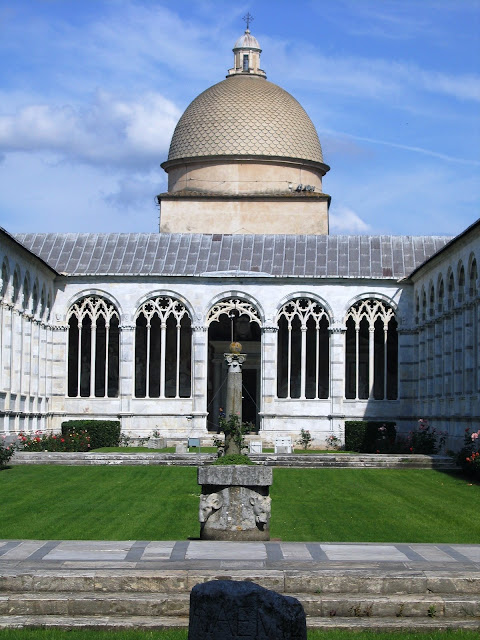The La campanile - better known as the Leaning Tower
Il Duomo (cathedral)
Il Battistero (the baptistery)
Il Camposanto ("Holy Field", or cemetery)
The Leaning Tower is the raison d'etre of tourism to Pisa. It has been an attraction ever since it was built (leaning). It was begun in 1173 and strate dto tilt before reaching the third storey. It was completed in 1350. A fantastic history of the tower, and the politics around it can be read in the very entertaining and easy to read book Tilt by Nicholas Shrady.
The Cathedral was begin in 1064. It is a wonderful example of Pisan - Romanesque architecture.
The Baptistery was begun in 1152 and finished a century later. It was begun in Romanesque style and finished in Gothic style by Nicola and Giovanni Pisano.
The Camposanto was begun in 1278 by Giovanni di Simone. World War 2 bombs destroyed much of the frescoes. There is a major restoration underway.
Below: Approaching the piazza, past the tourist stalls.
 Below: The cathedral, roof of the baptistery and leaning tower.
Below: The cathedral, roof of the baptistery and leaning tower. Below: One good shove.
Below: One good shove. Below: ooops! Too far!
Below: ooops! Too far! Below: Oh no! It's going to topple the other way.
Below: Oh no! It's going to topple the other way. Below: Inside the cathedral. Playing with fire (artificial).
Below: Inside the cathedral. Playing with fire (artificial). Below: Ceiling and interior of the cathedral
Below: Ceiling and interior of the cathedral Below: Inside the baptistery from the gallery
Below: Inside the baptistery from the gallery Below: View of the cathedral and tower from the baptistery
Below: View of the cathedral and tower from the baptistery Below: The Leaning Cathedral of Pisa
Below: The Leaning Cathedral of Pisa Below: Nose in a book, baptistery, while mum lingers at photos
Below: Nose in a book, baptistery, while mum lingers at photos Below: The camposanto
Below: The camposanto

 Below: Frescoes in the camposanto
Below: Frescoes in the camposanto Below: Statue of Fibonacci
Below: Statue of Fibonacci
Fibonacci was a Pisan mathematician, whose name was Leonardo of Pisa (c. 1170 – c. 1250), also known as Leonardo Pisano, Leonardo Bonacci, Leonardo Fibonacci. Fibonacci is best known for spreading of the Arabic numeral system in Europe, primarily through the publication in the early 13th century of his Book of Calculation, the Liber Abaci, and a modern number sequence named after him known as the Fibonacci numbers, which he did not discover but used as an example in the Liber Abaci.
The nickname Fibonacci came about because his father Gugliemo was nicknamed Bonaccio ("good natured" or "simple"). Fibonacci is derived from filius Bonacci, meaning son of Bonaccio.
The statue was finished in 1863 and placed here to honour Fibonacci. It is not known what he looked like.
Below: Chains which used to close the medieval harbour of Pisa. They were taken by the Genoese rivals who won the Meloria battle in 1284 and they gave them back to the city only in 1860.

3 comments:
Yo, and guess who stabilised/straightened the tower? My namesake, Prof John Burland, of Imperial College, London.
At Pisa airport the customs official checked my passport description (eyes, brownish-greenish-grey) against my appearance, and found no discrepancy. Pisa is actually a wonderful Tuscan city. Problem is, folks want to hop off the train and run to the Leaning Tower. Never in history have so many wanted to visit an architectural embarrassment so badly.
---------------
Tanyaa
Advisor
To start earning money with your blog, initially use Google Adsense but gradually as your traffic increases, keep adding more and more money making programs to your site.
Post a Comment